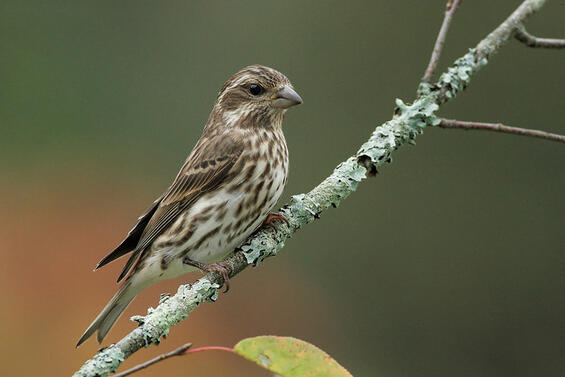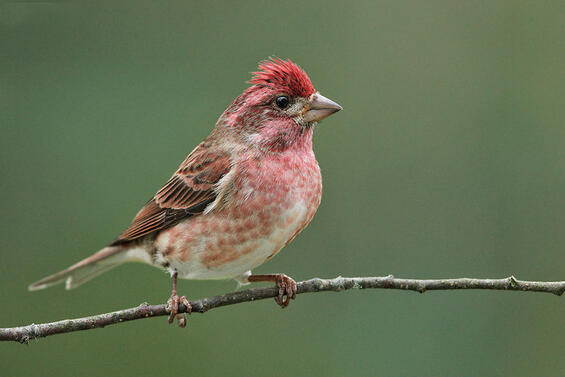- Scientific name: Haemorhous purpureus
- Species of Greatest Conservation Need (MA State Wildlife Action Plan)
Description
Purple finches are sexually dimorphic songbirds; the female (and immature males) has a sparrow-like plumage (brown back and streaks on chest), while only the adult male has the characteristic reddish-purple plumage for which the species is named. The species is similar to and often mistaken for the house finch, which is more common in urban and suburban areas.

Female purple finch (Haemorhous purpureus)
Life cycle and behavior
The purple finch is a migratory bird that has an erratic migration pattern dependent on food availability (conifer cone crops) throughout the boreal forest. High numbers of birds often winter in the southern United States. Massachusetts purple finches typically arrive in early spring to establish breeding territories. Nests are usually placed on a branch of a conifer tree and have a median clutch size of four eggs. Incubation lasts for about 12 days and chicks fledge from the nest 13-16 days following hatching. Pairs may produce two broods in a single season, but data on the frequency of this behavior is lacking. Nests are susceptible to brood parasitism by the brown-headed cowbird, especially in fragmented forest patches. Timing of fall migration is also variable and can be protracted, but most birds tend to move through New England from late September through October. However, nesting birds in Massachusetts may not migrate and be present throughout the year.

Phenology in Massachusetts. This is a simplification of the annual life cycle. Timing exhibited by individuals in a population varies, so adjacent life stages generally overlap each other at their starts and ends.
Population status
The purple finch has significantly declined in Massachusetts, New England, and throughout eastern North America since 1966. As a result of an estimated 0.73 annual decline, the population of the species was reduced by 32% between 1966-2019 in North America.
Distribution and abundance
The breeding range of the purple finch includes the northern portions of the eastern and central United States and southern Canada (boreal forest) and along the west coast. It can be found nesting throughout central and western Massachusetts, but purple finches have become increasingly uncommon as a breeding bird in eastern portions of the state.

Male purple finch (Haemorhous purpureus)
Habitat
Purple finches are classified as a habitat generalist and can be found nesting in a number of different habitat types. They primarily breed in moist coniferous or mixed forests, but can also be found in deciduous forests, orchards, pastures, hedgerows, and suburban areas.
Healthy habitats are vital for supporting native wildlife and plants. Explore habitats and learn about conservation and restoration in Massachusetts.
Threats
Strong declines have been documented in purple finch populations in both the United States and Canada, and there is evidence that these declines are a direct result of inter-specific competition with the introduced house finch.
Predation by domestic cats has been identified as the largest source of mortality for wild birds in the United States with the number of estimated mortalities exceeding 2 billion annually. Cats are especially a threat to those species that nest on or near the ground.
An additional threat to the species is collisions with buildings and other structures, as approximately 1 billion birds in the United States are estimated to die annually from building collisions. A high percentage of these collisions occur during the migratory periods when birds fly long distances between their wintering and breeding grounds. Light pollution exacerbates this threat for nocturnal migrants as it can disrupt their navigational capabilities and lure them into urban areas, increasing the risk of collisions or exhaustion from circling lit structures or areas.
Conservation
The protection of large tracts of forest habitat is important for the conservation of this species in Massachusetts. Such forests not only provide breeding habitat for the species, but the house finch in less likely to become established and out compete purple finches in these areas.
Promote responsible pet ownership that supports wildlife and pet health by keeping cats indoors and encouraging others to follow guidelines found at fishwildlife.org.
Bird collision mortalities can be minimized by making glass more visible to birds. This includes using bird-safe glass in new construction and retrofitting existing glass (e.g., screens, window decals) to make it bird-friendly and reducing artificial lighting around buildings (e.g., Lights Out Programs, utilizing down shielding lights) that attract birds during their nocturnal migration.
References
Sauer, J.R., J.E. Hines, J.E. Fallon, K.L. Pardieck, D.J. Ziolkowski, Jr., and W.A. Link. 2020. The North American Breeding Bird Survey, Results and Analysis 1966 – 2019. Laurel, MD.
Walsh, J. and W.R. Petersen. 2013. Massachusetts Breeding Bird Atlas 2. Massachusetts Audubon Society and Scott & Nix, Inc.
Wootton, J. T. (2020). Purple Finch (Haemorhous purpureus), version 1.0. In Birds of the World (A. F. Poole and F. B. Gill, Editors). Cornell Lab of Ornithology, Ithaca, NY, USA.
Contact
| Date published: | April 22, 2025 |
|---|